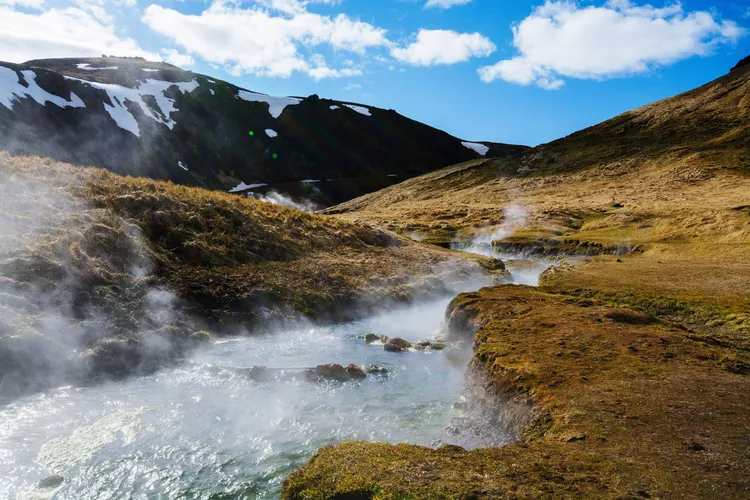1. Introduction to Reykjadalur Valley
2. Why It’s Worth a Visit
3. How to Get There
4. What to Expect
5. The Best Time to Visit
6. Safety Tips
Address
Reykjadalur 816, 816, Iceland
Ask any random group of ten people visiting Iceland for the first time why they’re going, and there’s a very good chance that hot springs will make the list. Although hot springs can be found in other countries, including the United States, there’s something exceptionally adventurous about having to work a little for your relaxing soak.
Iceland offers numerous hot springs that don’t require any hiking, such as Blue Lagoon, Myvatn Nature Baths, and The Secret Lagoon. However, Reykjadalur River is a unique experience you will only find in Iceland. Long after your trip, it will be a place to which your mind drifts when seeking a moment of relaxation.
The key thing to remember before visiting Reykjadalur is that it requires a commitment. The final destination isn’t visible from the parking lot, and there’s a hike involved. Yet, hikers are rewarded with a more authentic experience of Iceland’s hot springs, making the effort well worth it.
Ahead, we cover everything you need to know about exploring Iceland’s Reykjadalur River Valley.
Why It’s Worth a Visit
Hot springs play a tremendous role in Icelandic culture, as well as in Scandinavian and Nordic traditions. They serve as a gathering place for friends and family, a means to connect with nature, and, at times, a source of exercise. This is an experience you cannot miss during your trip to Iceland. While commercial spas like Blue Lagoon offer a general feel for the hot spring ritual, Reykjadalur provides a more authentic and off-the-beaten-path experience. Locals can often be seen walking to Reykjadalur on any given day, highlighting its genuine nature.
The accompanying hike distinguishes this hot spring location from others. There are no official changing rooms, and you will have to earn your relaxation through effort. On the journey to the hot springs, breathtaking sights of the river valley await. If you make time for one hot spring on your trip, let it be this one.
How to Get There
Reykjadalur Valley is located about 45 minutes east of Reykjavik by car. The drive consists of a single road, Þjóðvegur 1, which encircles the entire country. As you approach the town of Hveragerði, signs for the geothermal park will become visible, guiding you toward your destination. Follow these signs to a designated parking lot.
What to Expect
The parking lot is spacious and includes restroom facilities, making it advisable to visit these amenities before beginning your hike to the river. Upon leaving the parking area, follow the gravel path leading up the mountain, where small geysers—some appearing as boiling mud pits—can be spotted along the way. The hike will take approximately 40 minutes to an hour and involves some elevation, so proper preparation is essential. Don’t forget to carry a water bottle that can be refilled at safe mountain streams along the route.
While navigating the path, proceed with caution, as loose gravel can make footing tricky. However, there is ample space to accommodate hikers coming from both directions. At certain sections, the trail opens up to reveal stunning panoramic views of the river valley, providing both beauty and a sense of wonder.
As you near the hot spring river, the sulfuric odor will become more pronounced, marking the increase in geothermal activity in the area. Just before reaching the hot springs, you will cross a bridge often obscured by steam from the nearby geysers. Prepare for strong aromas at this point.
The hot spring river itself is as inviting as it sounds—warm enough for a relaxing soak. Be aware that the first stretch of the river you’ll encounter is cooler than sections further along. A wooden boardwalk runs next to the river: follow it toward the warmer areas at the far end of the boardwalk. The water can become quite hot near its source, so exercise caution.
If you prefer not to change in semi-public areas, consider wearing your swimsuit directly to the hot spring river. Although wooden dividers offer some privacy, complete seclusion is not guaranteed. In Iceland, nudity is generally accepted, and it’s common to see people changing behind these wooden screens.
You’ll likely be joined by both tourists and locals—this site also attracts runners and cyclists seeking a quick break before resuming their activities.
The Best Time to Visit
You can visit during the winter; however, hiking conditions are far more pleasant in warmer months. Keep in mind that you are more likely to encounter fewer bugs on chilly days, as small gnat-like insects can swarm hikers during warmer weather. The return journey is noticeably more comfortable, regardless of the season.
Safety Tips
Wearing proper footwear is crucial; flip-flops or any unfit shoes are ill-advised. The path includes areas of loose gravel, and crossing wet rocks may be necessary. Make safety a priority to avoid potential injuries. Also, don’t forget sunscreen or a bandana to shield against insects, especially in summer, and consider hiking with a companion for added caution.





